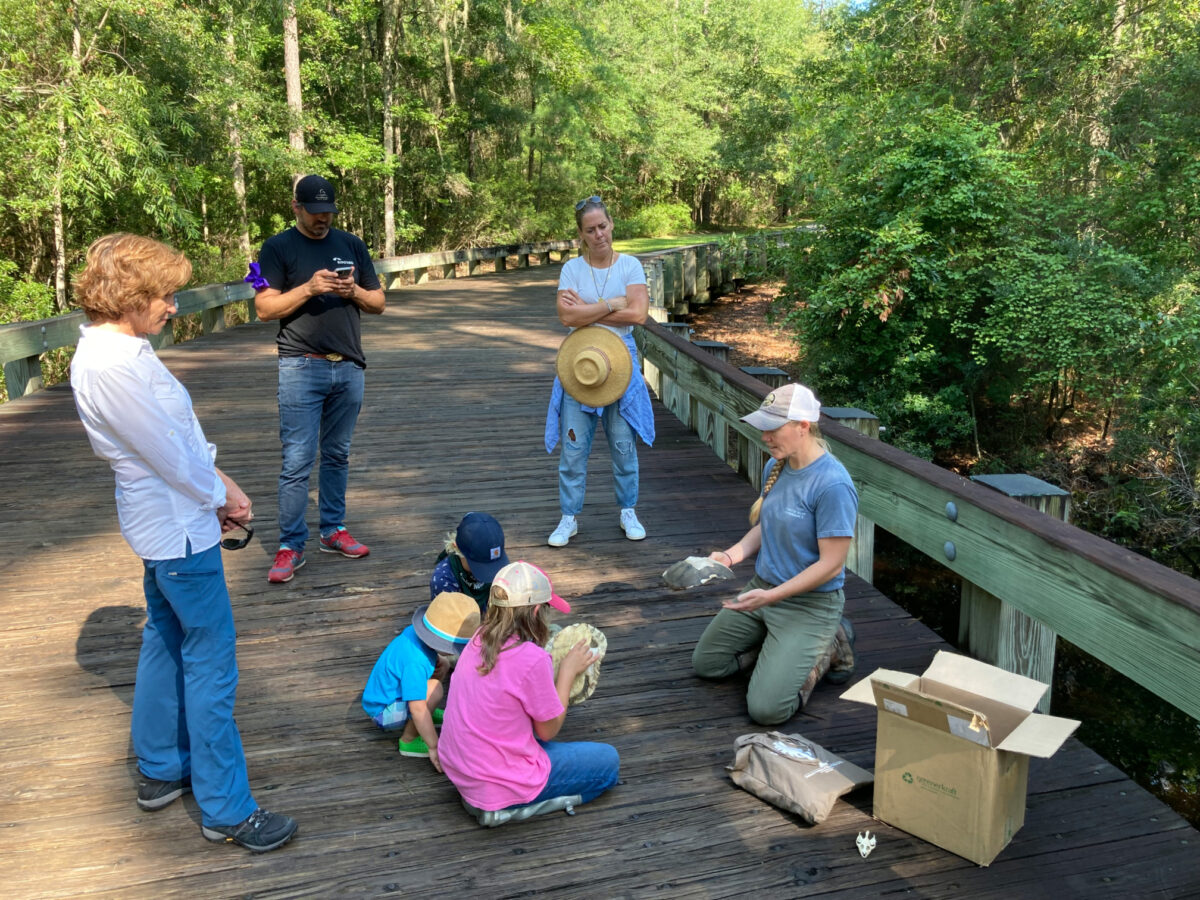Palmetto Bluff Real Estate Company Sales Office
Office Hours
Monday-Friday 9am - 5pm
Saturday 9am - 4pm
Sunday 12 - 4pm
Saturday 9am - 4pm
Sunday 12 - 4pm
I am Sam Holst, research fellow for the Palmetto Bluff Conservancy, a position graciously funded by the Friends of the Palmetto Bluff Conservancy. I am currently conducting a study on the summer roosting behaviors of Seminole bats (Lasiurus seminolus) at Palmetto Bluff. Seminoles are a foliage-roosting bat that can be identified by their pretty, mahogany fur. They have not been studied as much as other bats, even though they are one of the most common in South Carolina. This is due to most state and federal funding going towards threatened and endangered species rather than more common organisms. The Palmetto Bluff Conservancy is lucky to have the flexibility to study common species such as the Seminole bat as well as some rarer groups. Conducting research on common taxa is critical to prevent them from becoming uncommon in the future.

My study looks at the differences between male and female roost site selection compared to available roosts on the landscape. Previous studies of Seminole bats have shown contrasts in roost selection between sexes, so I presume that I will find similar differences. For example, female Seminoles have been documented roosting higher in the canopy and closer to forest edges while males have been documented roosting closer to forest passageways and clearer sections of forests. The primary difference that I expect to find when I start analyzing data is that females, on average, roosted higher in trees than males. This would most likely be due to the increased solar radiation higher in the roost trees, which increases the temperature of the roost. Female bats can conserve energy in these warmer roosts by preventing some heat loss during the day. Small mammals lose heat quicker than large ones due to a higher surface area-to-volume ratio resulting in faster heartbeats. Therefore, even on a hot summer day in the Lowcountry, these bats can benefit from roosting in warm places.
In order to find where Seminole bats are roosting, we must first catch and track them. We used mist nets to capture the bats as discussed in a previous post: From Dawn to Dusk: Netting Bats. Once a Seminole bat was caught, we affixed a transmitter to it. The transmitter was glued to the bat’s back right between the shoulder blades with the antenna running down the length of its back and past the tail membrane. Seminole bats are extremely furry, so we had to trim the fur as close to the skin as possible to clear a spot for the transmitter. If glued straight to the fur without trimming, the transmitter would fall off very quickly. For this study, we tracked eight adult Seminole bats (four male and four female) to their roost trees for up to seven consecutive days. Some bats were great at knocking their transmitters off, not allowing for a full seven days of tracking. To track, we used a receiver and an antenna. The antenna picks up the signal from the transmitter on the bat, and the receiver displays the strength of the signal. The signal is always strongest in the direction of the transmitter, showing me which way to navigate. The signal becomes stronger when getting closer to the transmitter, so we could tell approximately how far we needed to go to find the roost tree. As we approached where the bat was roosting, we would attempt to pinpoint which tree the bat was using.

Seminole bats roost high in the canopy, so determining the exact tree they were using was tricky. Once we tracked an individual to the presumed roost tree, we used a spotting scope to scan the canopy of the tree looking for the bat. Some days we could not find the bat in the tree, but when we did, we saw some surprising things. All the bats in the study were roosting in pine trees except one male that only roosted in hickory trees. We spotted Seminoles roosting in clumps of pine needles, on small branches – even on pinecones!

The male that roosted in hickories clung to nothing but the leaf petioles, the small stems that connect leaves to branches. We observed most of the bats roosting by themselves, slowly swaying in the gentle breeze going through the canopy. This is typical of Seminole bats, which tend to roost solitarily. However, we did observe several individuals roosting in groups of four with unbanded individuals (meaning these individuals had not been captured in our nets, as we band almost all the bats we catch). This was an exciting find because Seminole bats were presumed to be a solitary roosting species. The first group of bats spotted roosting together was when we were tracking an adult female, so we assumed that the other bats in the group were her offspring from earlier in the year. Later in the study, we tracked an adult male to a different group of four, making our original assumption incorrect. It would be fascinating to know if these were family groups roosting together, or just a small group of unrelated individuals.

After tracking was completed, we started recording vegetation plot data at each of the known roosts and two random sites per roost tree. We measured random sites so we could compare characteristics of the roosts used by bats with unused roosts that are available on the landscape. Some of the variables measured during vegetation plots focused on the roost tree itself (tree height, tree diameter, and canopy diameter) while other variables focused on the plot around the roost tree (flight space and canopy cover).

The purpose of measuring tree data as well as plot data is to determine whether the bats are selecting a roost for the tree itself or the habitat surrounding the tree. For example, we measured aspects of the roost tree to determine if bats were using the tallest, widest trees available on the landscape, or if they were selecting average-sized trees. Bats need space beneath their roost to drop into flight. Measuring the habitat around the roost gives us an estimate of how much flight space is available for the bat. Then we can determine the amount of flight space needed for Seminole bats to select a roost. We are determining if Seminoles have specific habitat requirements for roosting, or if they can tolerate a wide range of roosting conditions. Essentially, we are determining if Seminoles are generalists or specialists in their roost site selection. Additionally, we will look at some landscape variables such as distance to the nearest freshwater source to see if bats selected roosts due to proximity to resources.

In total, there were 144 vegetation plots. We had help from Conservancy staff and volunteers to get all of them finished just before October. It was imperative that vegetation plots were finished before fall fully set in, so the landscape was consistent throughout the study.

Now that all the vegetation plots are finished, the field work portion of the study is complete. We have learned a lot already about the roosting behaviors of Seminole bats from observations alone. The next step is to analyze the data collected over the summer to determine if there were any significant differences between selected and random roosts, and if there were differences in roost sites between males and females. Although I anticipate results similar to previous studies, bats near the coast have surprised us more than once. Look for my post next spring where I will give an update on all the exciting finds after analyzing the dataset.
Want to learn more about Sam and Lydia’s important work studying bats at Palmetto Bluff? Explore the Dusk to Dawn series, covering everything from common myths and urban legends to threats facing our winged friends. Learn more.

Photography by Summer Pagatpatan Bentley || Chocolate Labrador || Male || 9 Years Old Bentley is always happy to see anyone. He’s the fan favorite in our neighborhood and might bust down the door to see you! Bentley loves to go on a treat walk in Wilson ...

What’s more “summer” than tomatoes from the garden? Or, in Palmetto Bluff’s case–tomatoes from The Farm? We asked our newest addition to the Palmetto Bluff Club’s culinary team, Chef Beth, to share a classic summer staple from her library of recipes: Fattouche...

How did you two meet? Patti: We actually met in college but never dated. We went to Auburn University and both moved to Atlanta after graduation. He was in graduate school at Emory, and I worked as a nurse at Emory’s Children’s Hospital. Pat: Our friend grou...

Boat The Bluff: South Carolina Waterways Imagine gliding through serene, glassy waters surrounded by lush marshlands and maritime forests. Welcome to Palmetto Bluff, South Carolina—a paradise for nature enthusiasts, water sports aficionados, and anyone seekin...

Photography by Charlotte Zacharkiw The fourth of July is the highlight of the Palmetto Bluff calendar. Follow along with the Truslow family on this magical summer day. Neal and Lauren Truslow come to Palmetto Bluff as often as they can. Their kids...

Protecting Nature and History at Palmetto Bluff In the heart of South Carolina's Lowcountry lies Palmetto Bluff, a sanctuary of natural beauty, rich history, and vibrant ecosystems. Since its establishment in 2003, the Palmetto Bluff Conservancy has been dedi...

Photography by Gately Williams Cruise Control Palmetto Bluff lies at the heart of the vast network of rivers and creeks that connect the South Carolina Lowcountry’s barrier islands. A stone’s throw from the notable cultural and historic hubs of Savannah, B...

Tracy’s Journey to Palmetto Bluff Real Estate Situated in the heart of Bluffton, South Carolina, Palmetto Bluff is more than just a community—it's a place of magic and wonder. For Tracy Schyberg, a dedicated sales executive with the Palmetto Bluff Real Estate...

Enhancing Coastal Living With Lowcountry Landscaping Trends The Lowcountry lies along the southeastern coast of the United States, a region known for its breathtaking landscapes, rich history, and unique culture. From the charming streets of Charleston to the...

Palmetto Bluff Real Estate Available in Moreland Forest Nestled in the heart of the Lowcountry, Moreland Forest is a charming neighborhood known for its beautiful natural surroundings, Lowcountry architecture, and luxurious amenities. Within the lush forests ...
Learn about the Palmetto Bluff Conservancy and how we keep the vision of our land in place.
On land or water, there is an ever-evolving variety of activities.
We do not attempt to independently verify the currency, completeness, accuracy or authenticity of the data contained herein. All area measurements and calculations are approximate and should be independently verified. Data may be subject to transcription and transmission errors. Accordingly, the data is provided on an “as is” “as available” basis only and may not reflect all real estate activity in the market”. © [2023] REsides, Inc. All rights reserved. Certain information contained herein is derived from information, which is the licensed property of, and copyrighted by, REsides, Inc.